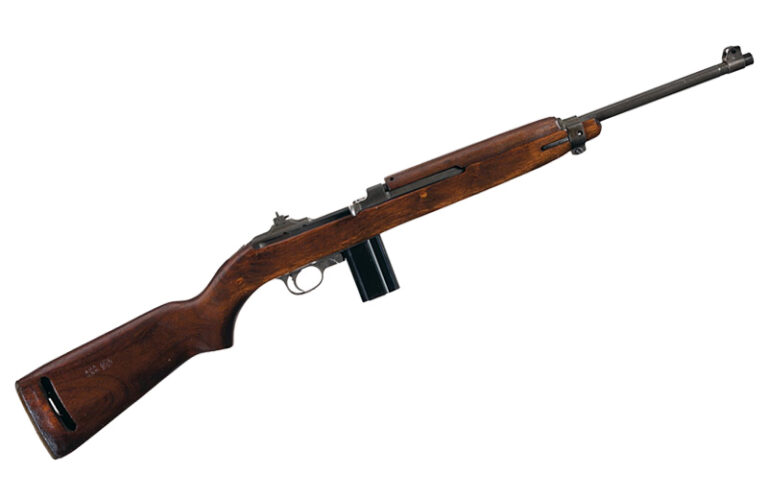
Ready to explore the fascinating world of the M1 Carbine? Whether you're seeking an original piece of history or a top-notch reproduction, we've got you covered.
The year was 1938 when the first request for a light rifle or carbine was made by the Chief of Infantry to the U.S. Army’s Ordnance Department. For support troops, those soldiers who kept the war machine rolling, the M1 Garand was too long and unwieldy, the Thompson submachine gun was too heavy and expensive and the M1911A1 pistol had limited range. An intermediate solution was needed for staff, officers, artillerymen, radiomen, drivers, NCOs, cooks in the chow hall and all the other soldiers that shore up combat troops.
The new rifle needed to be light, easy to maneuver with while slung over your back and chambered in a caliber between the powerful .30-06 Springfield cartridge of the Garand and the .45 ACP of the Thompson and the 1911. The result was the M1 Carbine.
It was lightweight at just over 5 pounds, only 35.6 inches in length (smaller than a yardstick) and chambered in the new .30 Carbine cartridge. Approval for the carbine came in 1940 when the world was in the throes of World War II and the M1 Carbine played a significant role in that conflict and several others that followed.
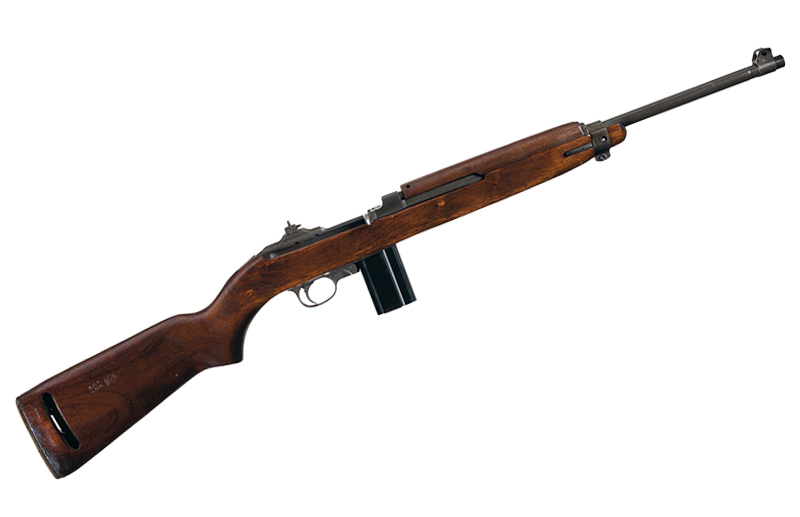
M1 Carbine Design
Before its adoption, the design of the M1 Carbine still needed to be drawn out, prototyped and tested. That didn’t happen in the offices and test labs of the Ordnance Department. The M1 Carbine design actually started on a Caledonia State Prison Farm in Halifax County, North Carolina.
A convicted murderer by the name of David Williams was an inmate in this minimum-security facility and had an aptitude for anything mechanical. Williams was especially good at designing firearms and he devised a short-stroke gas piston operating system for a rifle while serving his time. The gas system he devised became the basis for the M1 Carbine.
After Williams was paroled, he went to the War Department to show off his designs. In response, Army Ordnance suggested Winchester should hire the ex-convict, which it did. Williams, along with other Winchester engineers, then combined his short-stroke piston design with a rifle design that was started at Winchester by Ed Browning, John Browning’s brother.
By 1941, the final result was a carbine that used a rotating bolt, an operating slide and a short-stroke gas piston. When a shot is fired, gas is siphoned off to push back on the operating slide which then drives the rotating bolt rearward to eject a spent case. The recoil spring brings it all back home while scraping a fresh round out of the detachable box magazine.
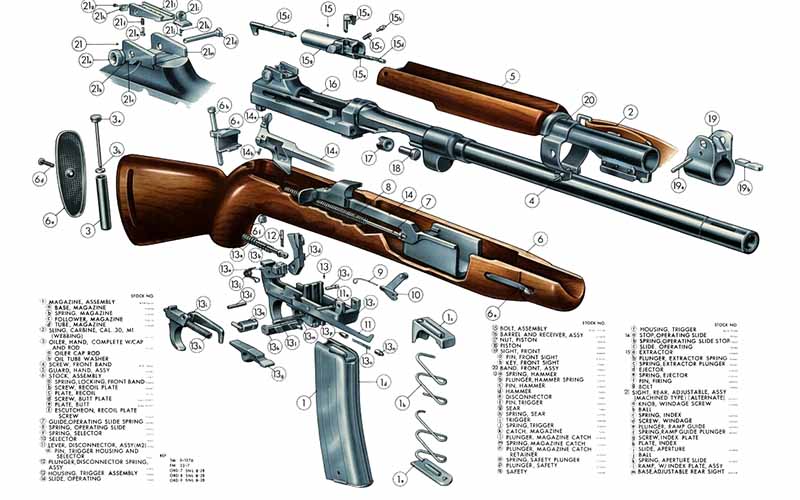
The new carbine was lighter than the 9.5-pound M1 Garand and almost 8 inches shorter in length. It was equipped with a smooth wood stock, a 17.75-inch barrel with a 1:20 twist rate and its sights consisted of a rear aperture and a front wing-protected post. The M1 Carbine featured a semi-automatic action and was fed from 15-round detachable box magazines. With the design established, the only obstacle left to tackle was production. Issue? The U.S. was going to need a lot of carbines to keep up with the war demand.
Production Ramp-Up During WWII
Winchester could not possibly build all the carbines needed. The U.S. government hired contractors to produce the M1 Carbine to bolster production numbers. By far the largest producer was the Inland division of General Motors, but some ten different contractors produced the M1 Carbine. These included IBM, Underwood, Rock-Ola Manufacturing Corporation, Quality Hardware and Machine Corp., Irwin-Pedersen Arms Company, National Postal Meter Company, Commercial Controls Corp., The Standard Products Company and Saginaw Steering Gear Division of General Motors.
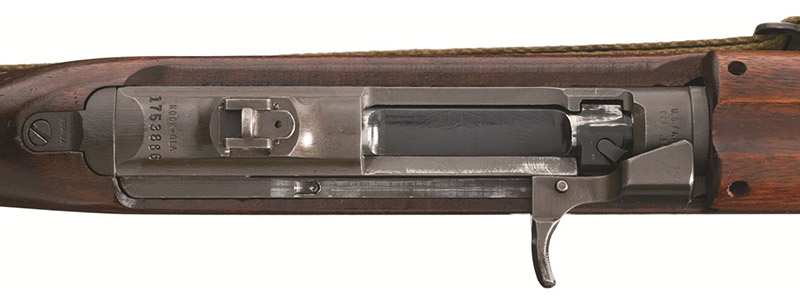
By mid-1941, the first M1 carbines were delivered to front-line troops with over 6 million M1 Carbines produced before the end of World War II. By that time, four official variants and a few more sub-variants had been produced. In 1945, military production of the M1 Carbine family stopped.
The M1 Carbine In Combat
For the most part, the M1 Carbine performed as designed. In combat use, it was small in size, lightweight and maneuverable, plus it had firepower with 15- and later 30-round magazines. However, the edge the M1 Carbine had in handling was hampered by the reputation surrounding the performance of .30 Carbine ammunition.
Action reports from WWII told of soldiers having to shoot enemy combatants multiple times before they went down. Some theorize this had more to do with the soldier's aim and missing shots they believed were hits, rather than the cartridge's supposed anemic ballistics.
Much of the lore surrounding the cartridge's stopping power seems to be a myth in retrospect. On paper, the .30 Carbine has decent ballistics for a cartridge its size. Despite reports from the Korean War, modern testing has conclusively debunked the idea the frozen jackets of Chinese troops were enough to stop .30 Carbine. The cartridge has proven capable of penetrating some level IIIA soft armor, in turn, poor effect on targets was more likely due to subpar shot placement. That said, it obviously can’t hold a candle to .30-06.
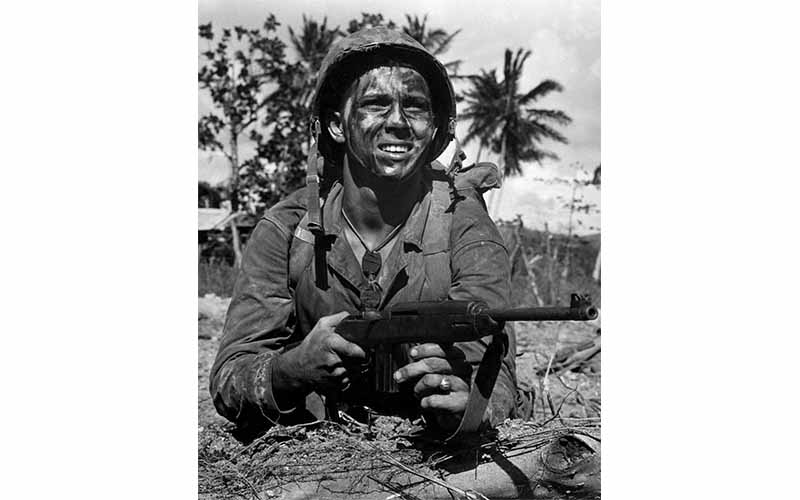
Despite its reputation, regardless of its validity, the use of the M1 Carbine by U.S. troops spanned not only WWII, but the Korean War and the Vietnam War as well. American troops weren’t the only ones to shoulder the M1 either, as some of our allies used the rifle during these conflicts. Due to the sheer volume of production and wide proliferation, the carbine later saw considerable use in conflicts without direct American involvement too. Some American law enforcement agencies from the 1950s through the 1970s utilized the M1, and here it earned a generally better reputation than it did with military users.
.30 Carbine Ballistics
The .30 Carbine cartridge was designed as an in-between caliber. Because it’s typically compared to higher velocity and more powerful loads, it is often considered underpowered. Winchester chose the .32 Winchester Self-Loading cartridge (.32 WSL) as the parent case for the .30 Carbine, but it was modified to a rimless case design and featured a smaller diameter bullet. While the .32 WSL was in the same class as the .32-20—not a sizzler by any stretch of the imagination—the propellants produced in the 1940s marginally cranked up the performance of .30 Carbine.
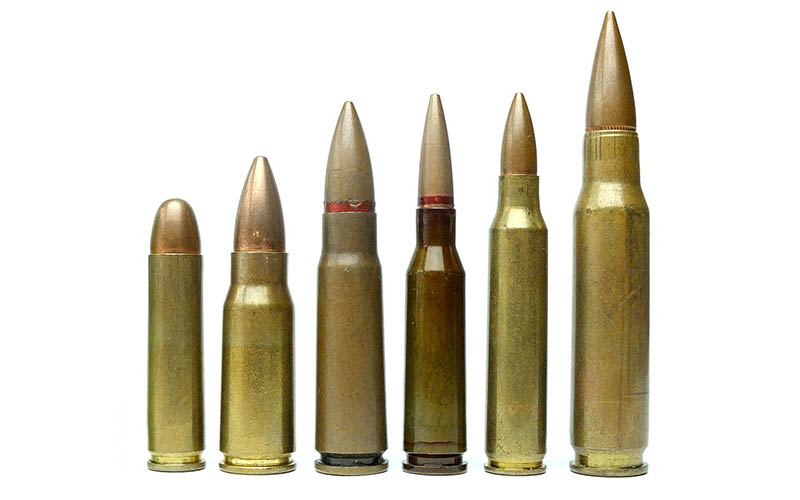
The M1 Carbine pushes a 110-grain bullet with an average muzzle velocity of 1,990 fps and produces an average muzzle energy of 967 foot-pounds. As per Hatcher’s Notebook, the Cal. .30 M2 ball ammo of the Garand was loaded with a 152-grain bullet and had an average muzzle velocity of 2,805 fps and a muzzle energy of 2,656 foot-pounds.
Comparing the two, .30 Carbine has about 29-percent less muzzle velocity and 63-percent less muzzle energy. Compared to .45 ACP fired from a 1911, however, the .30 Carbine has an edge. The standard .45 ACP loading of the day used a 230-grain FMJ with a muzzle velocity of 830 fps and 352 foot-pounds of muzzle energy on average. That means that .30 Carbine has about 140-percent more muzzle velocity and about 175-percent more muzzle energy than .45 ACP when fired from their respective WWII-issue weapons. Considering that the M1 Carbine was intended as a replacement defensive weapon for personnel that would have otherwise been issued a 1911, that’s not bad at all.
Modern .30 Carbine Ammo
Fresh .30 Carbine ammo is still relatively plentiful today. Remington, Federal, Aguila, IMI, PPU, Magtech, Winchester, Hornady, Buffalo Bore, Sellier& Bellot and others all produce it. The bulk of these are target loads featuring a typical 110-grain FMJ bullet. However, companies like Hornady and Underwood offer some defensive loads as well such as the 110-grain FTX and the 85-grain Lehigh Xtreme Cavitator. Hunting ammo choices are mainly composed of soft-point 110-grain bullets.
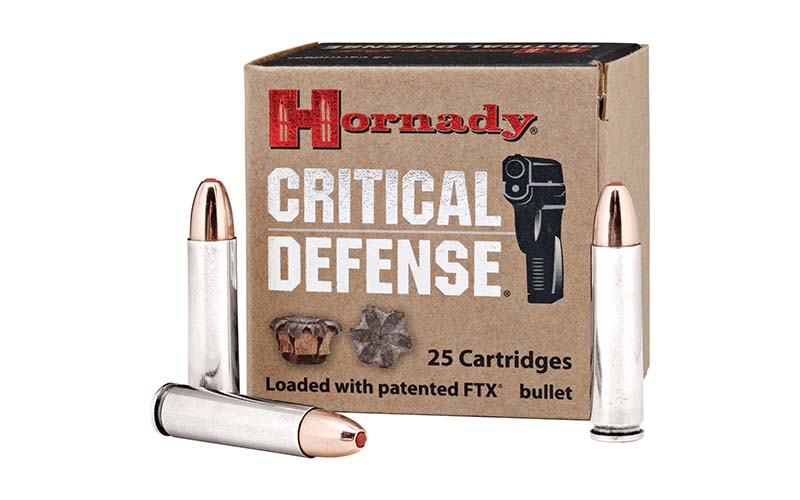
All I can say about .30 Carbine is it can kill deer at close range, meaning under 100 yards. I have hunted whitetail deer with the .30 Carbine and it can fill your freezer. I’ve used Hornady ammo with good results, but that said, I would not recommend going out of your way to use the .30 Carbine for deer hunting given the abundance of other options today.
M1 Carbine Major Variants
M1 And M1A1 Carbines
The original and most common version of the carbine is the standard M1, featuring smooth wood stocks and non-adjustable, flip-over rear sights with apertures for 100- and 300-yards. The M1A1 Carbine sports a side folding wire stock instead, but is otherwise identical to the M1. The M1A1 is also known as the paratrooper model given it was designed to be used by U.S. Army Airborne units.

M2 And M2A1 Carbines
With the introduction of the M2 variant in late 1944, the carbine was given select-fire capabilities and a 30-round magazine. This variant was widely used during the Korean War, much more than in WWII where they only witnessed the tail-end of the conflict. The M2 paratrooper variant was designated the M2A1 and was similar to the M1A1.
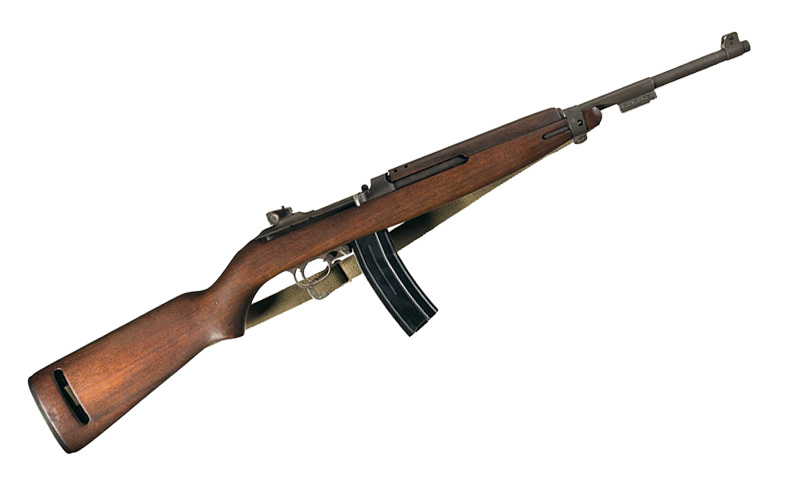
M3 Carbine
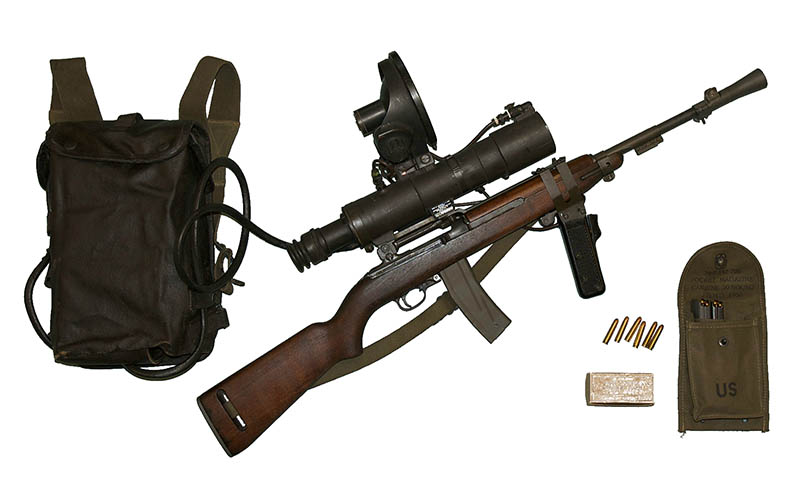
Perhaps the most unique variant was the M3. This version was just an M2 fitted with a mount for early-generation infrared night vision scopes. The whole setup weighed over 30 pounds, and despite being cutting-edge technology for its time, the scopes only had an effective range of about 70-100 yards.
M1 Variant Nuances
Sights
Early M1s had a non-adjustable rear sight. This sight had two apertures, one for 100 yards and one for 300 yards. By the end of WWII, an adjustable rear sight had replaced the original flip-up rear sight.
Barrel Bands
There were also three types of barrel bands on M1 Carbines.
Type 1: This was the most common variation and featured a narrow band retained by the band spring.
Type 2: This M1 appeared in 1944 with a wide band that better secured the barrel to the stock.
Type 3: By 1945, this variation included a bayonet lug as well. Many M1s had their barrel bands upgraded to the Type III after 1945.
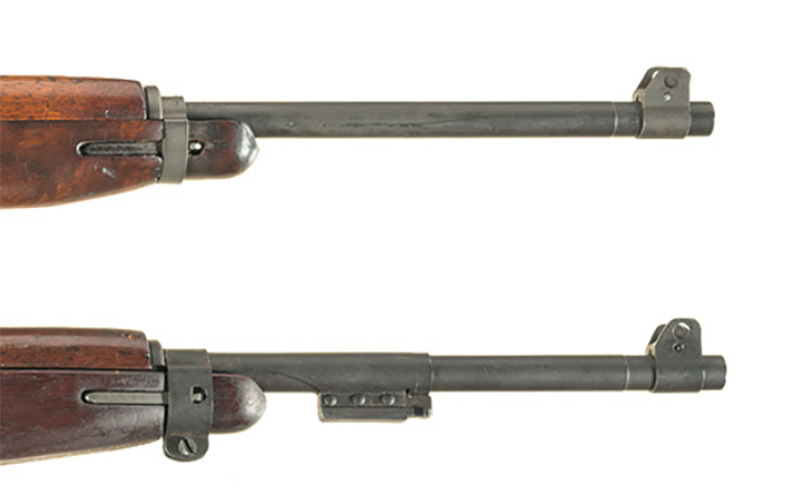
M1 Carbine Stocks
Stocks are also classified into three types.
Type 1: These stocks are the earliest and are referred to as “high wood” with the stock nearly covering the operating handle and featuring an I-shaped oiler slot in the rear stock. The oiler also held the canvas sling in place.
Type 2: These stocks are wartime production and feature an oval oiler slot and high wood. The high wood stocks were easily damaged, so the
Type 3: This stock, called low wood, was designed and used from 1944 onward. As the name implies, the stock was cut away from the operating handle.This variation also features an oval oiler slot.
It's worthwhile to note, the forend profiles of early stocks are straight while later-production stocks had a “pot belly” that sloped down. Early handguards also had two rivets while later variants had four.
Safety
The safety is another feature that changed during war production. Early guns had a push-button safety which was similar in size to the magazine release. To avoid confusion among soldiers, the safety was replaced with a rotary-style safety. Many M1s were later retrofitted with a rotary safety as well.
Surplus M1 Carbines
By the mid-1950s, surplus M1 Carbines started to become available on the commercial market. The CMP sold surplus M1 Carbines for $18.50, and at the time would ship them directly to your house (ah, the good old days). Carbines, ammo and extra magazines were all in abundance in those days.
Many veterans bought them due to familiarity and nostalgia, others purchased them for home defense given how handy and easy they are to shoot. Many also enjoyed using the carbine for hunting small- to medium-size game.
Even in the 1980s, M1 Carbines were regularly seen on the used rack in gun stores. Prices back then were about $200 to $300. Some 200,000 M1 Carbines from South Korea were allowed to be sold in the U.S. under the Reagan administration. The days of inexpensive surplus M1 Carbines, however, are now over.
The Clinton administration blocked sales of surplus M1 Carbines from the Philippines, Turkey and Pakistan. The Obama administrated similarly axed surplus sales of M1s from South Korea in 2010. These guns qualify as “curios or relics” and are legal to sell in the U.S., but they were sadly destroyed instead. There are probably still more M1 Carbines sitting in warehouses abroad, but the odds of them ever being imported are disappointingly slim.

Collecting The M1 Carbine
When it comes to collecting the surplus M1s that are already circulating on the secondhand market it’s, unfortunately, a tough nut to crack. This is because there are a ton of very minute, nuanced details that can majorly impact a carbine’s value. If you really want to get into it, you will need to do research beyond the information provided in this article.
The general condition, the rarity of the manufacturer or variant, the originality, subtle details like the barrel band or stock pattern and even a gun’s serial number can all play a huge role. There are also forgeries to watch out for on top of learning how to identify original features. These are all things that you can teach yourself, but it will require time and dedication before you’re educated enough to start dropping large sums on expanding your collection without worrying about getting scammed.
Reproduction M1 Carbines
After WWII, several firearms manufacturers produced copies of the M1 Carbine. Iver Johnson, AMPCO, Erma, Universal Firearms and Plainfield Machine Company are just a few that have existed over the years. The quality varied among these manufacturers, with some using a mix of original surplus and new-production parts and others building them with entirely new commercial components. Not all GI parts are compatible with commercial guns.
Currently, there are still a few manufacturers cranking out reproduction M1 Carbines. Inland Mfg. (which is not the original Inland Mfg. but a new company started in 2013), Auto-Ordnance (which is part of Kahr Arms) and Chiappa are three of them. Of these, some are more faithful reproductions than others, with some true clones and others the company’s interpretation of the M1. Chiappa’s, for instance, is chambered for 9mm or .22 LR and uses a blowback action.

What Sort Of M1 Carbine Should I Buy?
When considering an M1 Carbine, you need to ask yourself: Do I want to continue to shoot an original which will diminish its value, or shoot the heck out of a reproduction? My thought with reproduction guns is not to give it a hallowed slot in my gun safe, but to shoot it a lot.
Inland Mfg. offers eight variants of the M1 Carbine, and my favorite is the 1945 M1 with a Type III barrel band. While some of the Inland M1 Carbines take creative license with the look and features. However, when you shoulder an Inland Mfg. M1 1945, it makes you wonder whether it just came off the production line in 1945. It even has period-correct features like a round bolt and low wood stock. The new Inland Mfg. M1 Carbines are so close to original specifications Inland marks the underside of the barrel and inside the stock to prevent these carbines from being sold as WWII-vintage firearms by unscrupulous gun traders.

Another favorite of mine is the Auto-Ordnance M1 Carbine Paratrooper, which is a reproduction of the M1A1 with a folding wire stock. Add shooting the Paratrooper from the hip with the stocked folded to your bucket list. You'll have a silly grin on your face after running through a 30-round mag.
Given the collectability of surplus guns, reproductions allow one to shoot them as much as desired without worrying about eroding the value of an original. Reproductions also cost less than originals and are pretty much guaranteed to run out of the box, while surplus guns often need some tweaking and some cleaning.
Getting Started With An M1 Carbine
There are a lot of complexities and nuances to collecting surplus M1s. There is also the expense.
If you have your heart set on a surplus M1, expect to pay anywhere from $1,500 to $2,000 for a shooter in good condition. Rebuilds are cheaper but will have mismatched parts, but that's alright for a gun you are going to shoot. Reproductions are, honestly, the best option if all you want is a range toy. These guns are less expensive, but won't appreciate in value like originals.
Regardless of the exact variant you end up with, M1 Carbines are a ton of fun to shoot and will forever hold a prominent space in the pantheon of historically significant military small arms.
More Classic Military Guns:
- Why The Mauser C96 “Broomhandle” Still Looms Large
- Nagant Revolver: Unique Relic From Behind The Iron Curtain
- M1917 Enfield: The Unofficial U.S. Service Rifle
- Browning Automatic Rifle: The Gun That Changed the Infantry

Next Step: Get your FREE Printable Target Pack
Enhance your shooting precision with our 62 MOA Targets, perfect for rifles and handguns. Crafted in collaboration with Storm Tactical for accuracy and versatility.
Subscribe to the Gun Digest email newsletter and get your downloadable target pack sent straight to your inbox. Stay updated with the latest firearms info in the industry.

![Best Concealed Carry Guns In 2025 [Field Tested] Wilson Combat EDC X9S 1](https://gundigest.com/wp-content/uploads/Wilson-Combat-EDC-X9S-1-324x160.jpg)


![Best 9mm Carbine: Affordable PCCs [Tested] Ruger Carbine Shooting](https://gundigest.com/wp-content/uploads/Ruger-Carbine-Shooting-100x70.jpg)
![Best AR-15: Top Options Available Today [Field Tested] Harrington and Richardson PSA XM177E2 feature](https://gundigest.com/wp-content/uploads/Harrington-and-Richardson-PSA-XM177E2-feature-100x70.jpg)
